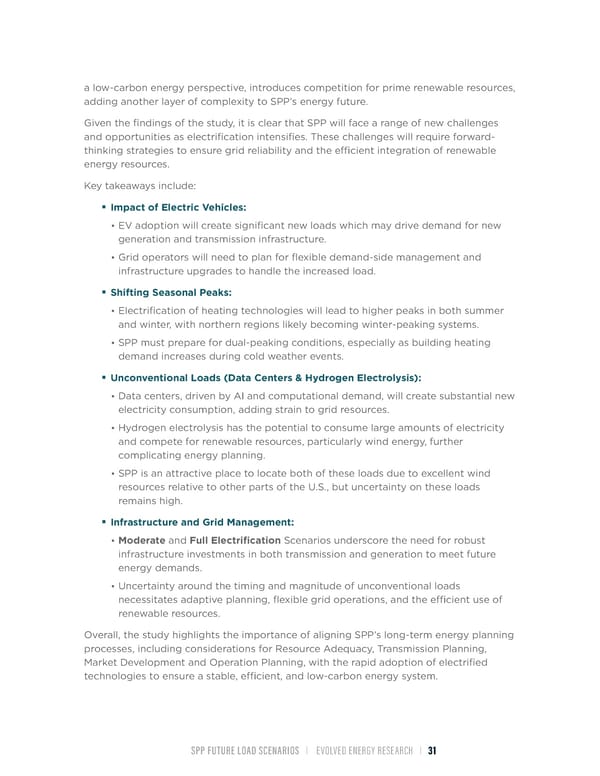a low-carbon energy perspective, introduces competition for prime renewable resources, adding another layer of complexity to SPP’s energy future. Given the findings of the study, it is clear that SPP will face a range of new challenges and opportunities as electrification intensifies. These challenges will require forward- thinking strategies to ensure grid reliability and the efÏcient integration of renewable energy resources. Key takeaways include: ƒ Impact of Electric Vehicles: • EV adoption will create significant new loads which may drive demand for new generation and transmission infrastructure. • Grid operators will need to plan for flexible demand-side management and infrastructure upgrades to handle the increased load. ƒ Shifting Seasonal Peaks: • Electrification of heating technologies will lead to higher peaks in both summer and winter, with northern regions likely becoming winter-peaking systems. • SPP must prepare for dual-peaking conditions, especially as building heating demand increases during cold weather events. ƒ Unconventional Loads (Data Centers & Hydrogen Electrolysis): • Data centers, driven by AI and computational demand, will create substantial new electricity consumption, adding strain to grid resources. • Hydrogen electrolysis has the potential to consume large amounts of electricity and compete for renewable resources, particularly wind energy, further complicating energy planning. • SPP is an attractive place to locate both of these loads due to excellent wind resources relative to other parts of the U.S., but uncertainty on these loads remains high. ƒ Infrastructure and Grid Management: • Moderate and Full Electrification Scenarios underscore the need for robust infrastructure investments in both transmission and generation to meet future energy demands. • Uncertainty around the timing and magnitude of unconventional loads necessitates adaptive planning, flexible grid operations, and the efÏcient use of renewable resources. Overall, the study highlights the importance of aligning SPP’s long-term energy planning processes, including considerations for Resource Adequacy, Transmission Planning, Market Development and Operation Planning, with the rapid adoption of electrified technologies to ensure a stable, efÏcient, and low-carbon energy system. SPP FUTURE LOAD SCENARIOS | EVOLVED ENERGY RESEARCH | 31
 Future Load Scenarios for Southwest Power Pool Page 32 Page 34
Future Load Scenarios for Southwest Power Pool Page 32 Page 34